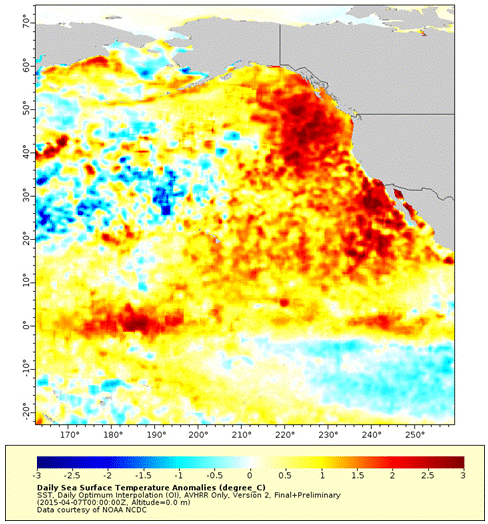The “Blob" is the name given by Nicholas Bond of the University of Washington to an area of unusually warm water off the Pacific Northwest of North America (Gulf of Alaska). It was first detected by satellite imagery in the fall of 2013 as an irregularly shaped area roughly 1600 km (1000 mi) long and 1600 km wide. By the spring of 2014, the Blob had not cooled as expected. In April 2015, the warm anomaly extended almost continuously from the Gulf of Alaska southward to Baja California, with surface water temperatures observed to be as much as 3°C (5.4°F) warmer than the expected long-term average. See also: North America; Ocean; Pacific Ocean; Satellite meteorology

What appears to have sustained the Blob is a persistent ridge of high atmospheric pressure (that is, a weather pattern) that since 2013 blocked winds and storms from bringing cooler air and water from higher latitudes and prevented cooler, deeper water from mixing with warmer surface water. In other words, the Blob did not form because of ocean warming but instead because of calm surface water. See also: Air pressure; Atmospheric general circulation; Maritime meteorology; Ocean circulation; Upwelling
The cause of what is now referred to as the “ridiculously resilient ridge” has not been completely determined but Dennis Hartmann of University of Washington reported in Geophysical Research Letters (March 2015) that bands of cool and warm tropical Pacific seawater, called the North Pacific Mode, set up the atmospheric conditions for the formation of the high-pressure ridge over the North Pacific. The North Pacific Mode also is believed to be responsible for the atmospheric circulation patterns that brought warm and dry air to the Pacific coast, fueling its drought, and cold, wet air to the central and eastern United States in the 2014 winter.
According to ocean-atmosphere model forecasts, the Blob is not expected to last another year, as the ridge will be gone and storms will return. However, do not expect the warm water to disappear too quickly, as mixing of the warm surface water with cooler water below is a slow process. See also: Weather forecasting and prediction





